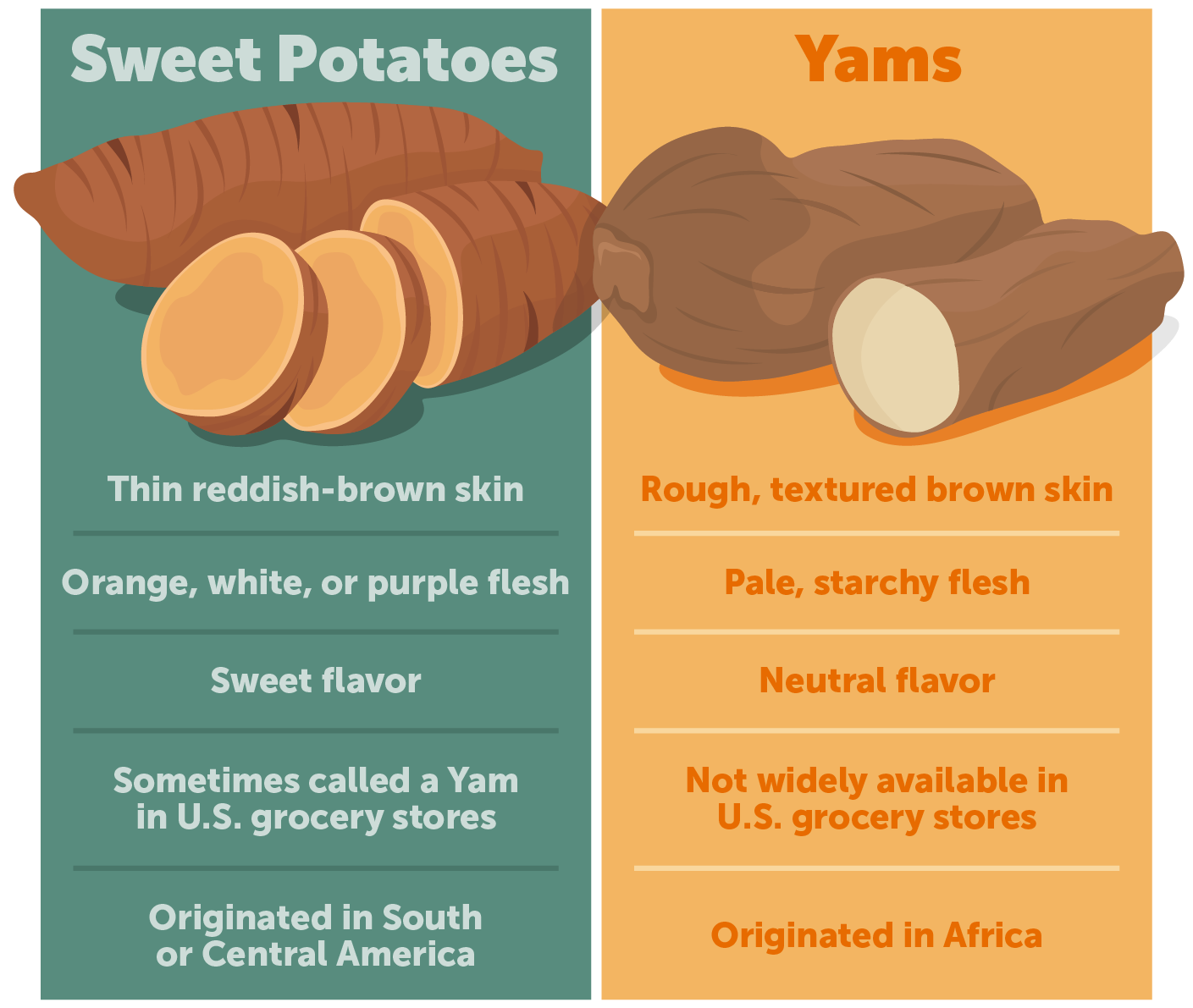Sweet Potato vs Yam: What's the Difference?
As you update your menu with fresh seasonal produce(opens in a new tab), have you ever found yourself wondering, "What's the difference between yams and sweet potatoes?" Sweet potatoes and yams have a bad reputation for getting mixed up, especially during the fall season. We'll explain the difference between yams and sweet potatoes and put an end to the longstanding debate.
Sweet Potato or Yam?
Watch our quick video to learn how these edible tubers are different:
You can see the differences between sweet potatoes and yams illustrated below:

Sweet potatoes have thin, reddish-brown skin, while yams have rough, textured brown skin. Yams have a starchy, neutral flavor and sweet potatoes have a sweet flavor.
Are Yams and Sweet Potatoes the Same?
No, yams and sweet potatoes are not the same. Yams have rough, dark brown skin that is often compared to tree bark, and their flesh is dry and starchy like a regular potato. Sweet potatoes have smooth reddish skin, softer flesh (when cooked), and a sweet flavor. You don't have to worry about mixing them up while you're shopping because true yams are rarely found in American grocery stores. The popular canned yams that you see around the holidays are technically sweet potatoes.
Use this as a guide to determine yam vs sweet potato:
- Sweet Potatoes - The most common varieties of sweet potatoes in the US have smooth orange or reddish skin, orange flesh, and a sweet flavor.
- Yams - Yams have rough brown skin like tree bark, white flesh, and a neutral flavor.
If you still aren't sure, an easy trick to tell the difference between sweet potatoes and yams is to look for eyes on the skin. Yams develop eyes or buds just like a regular potato, but a sweet potato does not. Instead, sweet potatoes may have fine roots on their skin, just like beets or carrots.
Why Do Yams and Sweet Potatoes Get Mixed Up?

You'll find that sweet potatoes are often labeled as yams. Some folks insist they eat yams every year at Thanksgiving, even though they've never seen a true yam. Why do they get mixed up if they are so different? There are a couple reasons why the word yam is used so widely as a nickname for the sweet potato.
In the early 20th century, sweet potato growers in the Southern US adopted the African word for yam to market their orange-colored potatoes and distinguish them from regular potatoes. The nickname "yam" stuck, and many producers use the name on their products to this day. Because these yams are technically sweet potatoes, the US Department of Agriculture requires that the label "yam" be accompanied by an additional label of "sweet potato".
What Is a Yam?


Yams are edible stem tubers native to the tropical regions of Africa and Asia. Because yams have dry starchy flesh, they can be stored in humid environments without fear of spoilage. This makes them an excellent staple food in the tropical climates where they are grown.
There are many varieties of yams, like Chinese yam, yellow yams, and ube, but the most cultivated type has pale white flesh. Yams can grow to be quite large, weighing many pounds and measuring multiple feet, or they can be the size of a standard potato.
Are Yams Potatoes?
Yams are not a type of potato. Both are stem tubers that grow underground, but they belong to different botanical families. The potato is a part of the nightshade family, which also includes peppers and tomatoes. Yams belong to a plant family of flowering vines that surprisingly includes grasses and lilies.
What Do Yams Taste Like?
Compared to sweet potatoes, yams have an earthy, neutral taste. They can be mildly sweet but mostly take on the flavor of the seasonings used in the dish. Yams must be cooked before eating because they are toxic when eaten raw. The leaves and stems are also poisonous and must be removed.
Yams are extremely versatile, and the flesh can be fried, roasted, or boiled. In West Africa, boiled yams are mashed or pounded into a paste to be added to soups. Raw yam slices are left out in the sun to dry and then ground into powder. The yam powder is added to boiling water to create a thick, starchy paste used in a side dish called amala. Amala is a thick, dark brown pudding served alongside soups.
Where To Buy Yams?
To find yams in North America, you must visit a specialty store. Caribbean or African food markets carry yams, and they're often cut into chunks or slices and wrapped in plastic. You can also find yams online, just make sure they are true African yams and not sweet potatoes.
What Are Sweet Potatoes?

Sweet potatoes are edible root tubers that originated in South and Central America. They are widely available in North American grocery stores, and you can buy fresh or canned sweet potatoes year-round, but their peak season is late October through December.
More closely related to the carrot than to the potato, sweet potatoes have thin skin and long tapered ends. The most common variety of sweet potato has orange flesh with smooth reddish-brown skin. Unlike yams, sweet potatoes can be eaten raw and their leaves can be cooked just like the greens from carrot or beet tops.
What Do Sweet Potatoes Taste Like?
Sweet potatoes have a naturally sweet flavor that is enhanced through cooking. Roasting or baking results in the caramelization of natural sugars for an even sweeter taste. Sweeteners like brown sugar, molasses, maple syrup, or even marshmallows are commonly used in sweet potato dishes to complement their unique flavor. Try sprinkling pumpkin pie spice over a baked sweet potato for a fall-inspired side dish.
Types of Sweet Potatoes
The copper-colored potato with orange flesh is probably what comes to mind when you think of the sweet potato, but there are many other varieties. Some of these types are even labeled as yams, but they aren't true yams. You'll find three major types of sweet potatoes at North American grocery stores:
- Orange Sweet Potato - Orange sweet potatoes are commonly labeled as yams. This variety is also called the soft sweet potato and has reddish-brown skin with bright, orange flesh. Popular varieties of soft sweet potatoes are the Jewel Yam and Garnet Yam.
- White Sweet Potato - Also called firm sweet potatoes, white sweet potatoes have light, golden skin and pale flesh. Unlike soft sweet potatoes, this variety remains firm and waxy after cooking. The Hannah Sweet Potato is one of the most popular white varieties.
- Japanese Sweet Potatoes - Japanese sweet potatoes are becoming a common sight in US grocery stores. They have deep purple or garnet-colored skin with white flesh that turns buttery yellow when cooked. You'll often see this sweet potato labeled as a "Japanese yam."
Now you know that you can't accidentally buy a yam instead of a sweet potato because true yams aren't available in most grocery stores. You've also learned that the word yam is sometimes used to differentiate the soft variety of sweet potato from the firm variety. You can shop with confidence and name your sweet potato dishes correctly because you understand the difference between these two vegetables.



